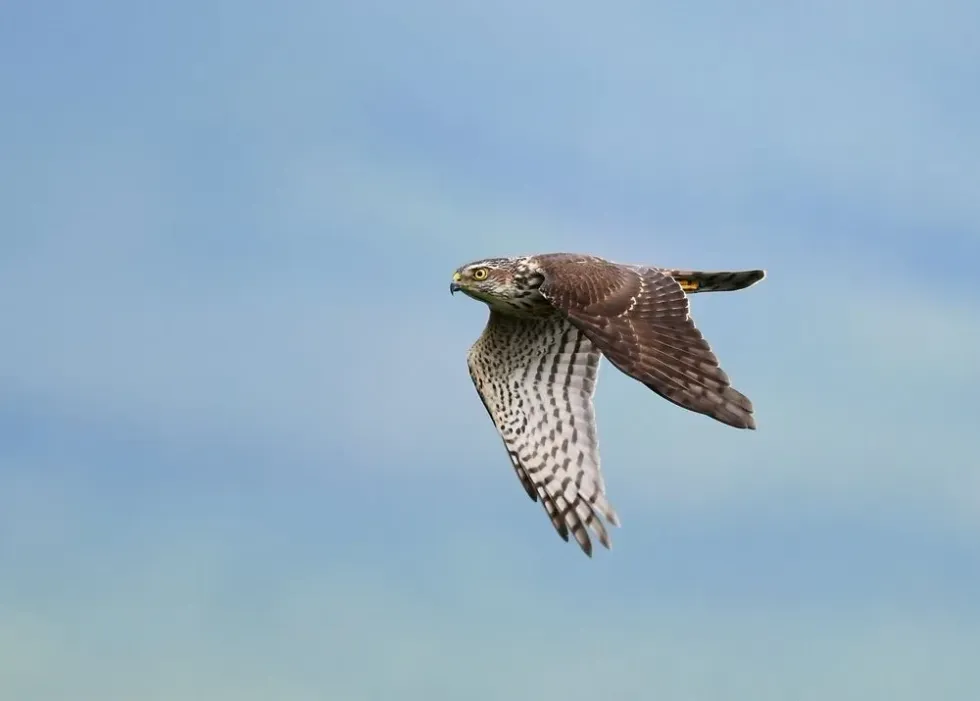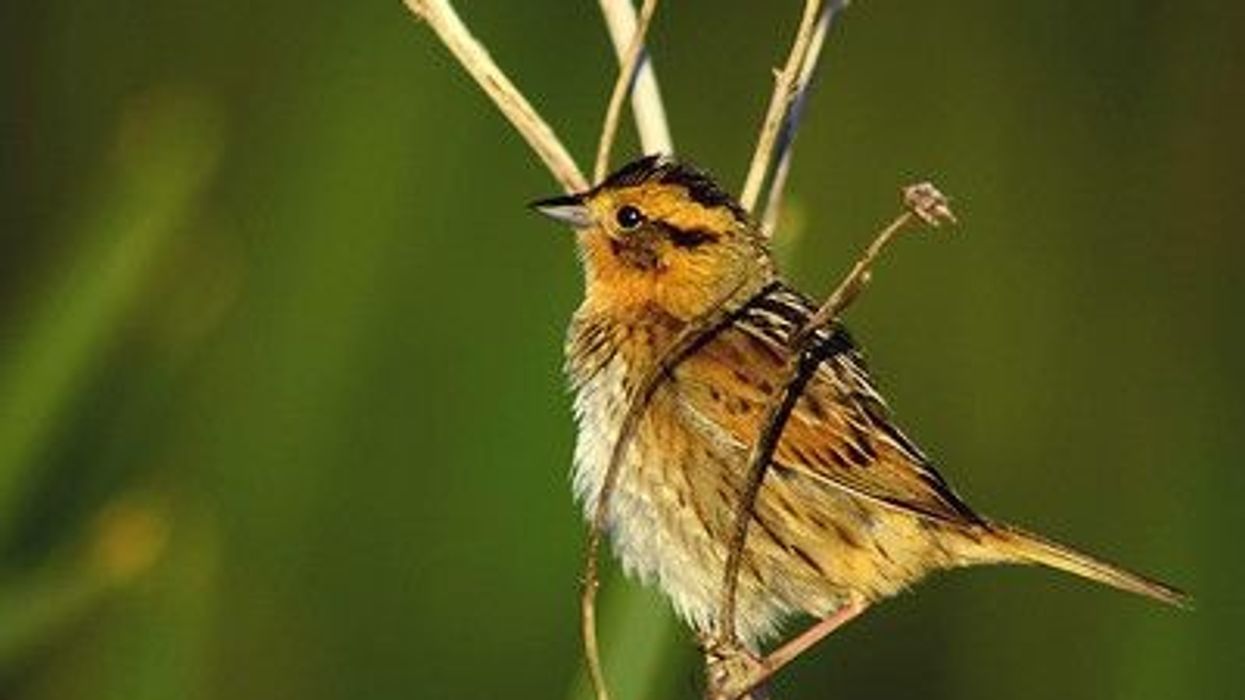There are a total of six subspecies under the sparrowhawk category. Some of them include the African little sparrowhawk, Eurasian sparrowhawk, and Japanese sparrowhawk among others. The Japanese sparrowhawk (Accipiter gularis) is a species native to southeast Asia. Sparrowhawk in Japanese is translated to 'suzume no taka'. They are seen in Japan, China, Korea, Indonesia, and the Philippines.
The Japanese sparrowhawk (Accipiter gularis) is migratory and stays away from winter climates in order to avoid the cold as well as find prey easily and belongs to genus Accipiter. The Japanese sparrowhawk (Accipiter gularis) is seen primarily in coniferous and deciduous forests.
Japanese sparrowhawk (Accipiter gularis) species are often confused with kestrels, hawks, and certain eagles however, they all belong to different families. They are primarily carnivorous in diet and they are voracious predators and can consume large amounts of food in no time even while in flight.
The Japanese sparrowhawk (Accipiter gularis) has excellent eyesight.
This article will look at some fun and interesting facts about the Japanese sparrowhawk. Don't forget to visit swallowtail and eastern kingbird articles if you like this one.
Japanese Sparrowhawk Interesting Facts
What type of animal is a Japanese sparrowhawk?
The Japanese sparrowhawk (Accipiter gularis) is a type of sparrowhawk animal and belongs to the order Accipitriformes.
What class of animal does a Japanese sparrowhawk belong to?
The Japanese sparrowhawk (Accipiter gularis) is a type of bird classified under the class Aves family Accipitridae and genus Accipiter which includes many other diurnal birds.
How many Japanese sparrowhawks are there in the world?
The Japanese sparrowhawks' exact population is not known. The Japanese sparrowhawk (Accipiter gularis) species are not thought to be threatened.
Where does a Japanese sparrowhawk live?
Japanese sparrowhawk locations range from Japan, China, Indonesia, Siberia, and the Philippines, Korea and passing through the rest of southeast Asia where it usually resides in winters. American sparrowhawks are one species native to the United States.
What is a Japanese sparrowhawk's habitat?
The Japanese sparrowhawk range is in coniferous and deciduous forest and wooded areas. There are chances for Japanese sparrowhawk (Accipiter gularis) species to visit areas near houses and farms as well to look for possible prey to feed on.
The Japanese sparrowhawk (Accipiter gularis) prefers staying at a low altitude range with evergreen forests and can be seen at elevations of 5905.5 ft (1800 m) during summer.
Who do Japanese sparrowhawks live with?
Japanese sparrowhawk (Accipiter gularis) is seen largely solitary when in flight and comes together for mating and raising offspring. It is seldom seen near people.
How long does a Japanese sparrowhawk live?
The Japanese sparrowhawk lifespan on average is four years.
How do they reproduce?
Japanese sparrowhawk (Accipiter gularis) breeding occurs through sexual reproduction between May and July. Males are smaller in length. The Japanese sparrowhawk (Accipiter gularis) builds a nest with twigs and foliage near a tree trunk. The parent breeds the young together.
The incubation period lasts 25-28 days. Females give birth to two to five eggs. The small bird starts fledging occurs one-month post-hatching and migrates in winters. The juvenile is dependent on its parents in the initial few weeks of its life until it develops proper wings.
What is their conservation status?
The Japanese sparrowhawk (Accipiter gularis) is classified as a Least Concern species by the International Union For Conservation Of Nature (IUCN). The IUCN list information includes many other diurnal bird species as well as those that are not as well as on their distribution.
Japanese Sparrowhawk Fun Facts
What do Japanese sparrowhawks look like?
Japanese sparrowhawks are species native to central and southeast Asia. Japanese sparrowhawk wings measure a total length of 51 cm. Females have yellow cere, yellow eyering, red eyes, and dark underparts as compared to males who usually have barred underparts, dark barred underwings, lightly colored underparts, brown upperparts, red eyes, dark gray upperparts, and a streaked breast.
These birds use their eyes to locate prey. Females are larger than male sparrowhawks.
Other similar-looking species include the besra sparrowhawk and Eurasian sparrowhawk. The male is short in length with the female if compared. They are seen primarily in the Philippines and Indonesia passing through the rest of Southeast Asia including China and Japan where it usually arrives in winters.

How cute are they?
The Japanese sparrowhawk (Accipiter gularis) is a majestic being and is similar to many other diurnal birds who are most active throughout the day including raptors, sparrow, hawk, and others and live in wooded areas in regions like China.
How do they communicate?
The Japanese sparrowhawk (Accipiter gularis) communicates via various means. The sparrowhawk (Japanese) mating calls are one of the types and other calls include the 'pyoh-pyo-pyo-pyo' with falling inclination used by both sexes to threaten predators. They don't utilize songs as much and instead make use of body language.
How big is a Japanese sparrowhawk?
The Japanese sparrowhawk size is 11.41-13.38 in (29-34 cm) with females larger than males. The Japanese sparrowhawk is hence two times bigger than the smallest sparrowhawk species at 9.1-10.6 in (23-27 cm). The little sparrowhawk is relatively small in size.
How fast can a Japanese sparrowhawk fly?
The Japanese sparrow hawk (Accipiter gularis) is estimated to fly at 31.1 mph (50 kph) and reside in wooded areas.
How much does a Japanese sparrowhawk weigh?
Japanese sparrow hawk (Accipiter gularis) birds weigh 0.2-0.42 lb (92-190 g). Black sparrowhawks are the heaviest and largest species of the sparrowhawk family.
What are the male and female names of the species?
Male and females are not addresses differently and can be distinguished on the basis of their outward appearance and reproductive functions. Females are larger than the male and both have barred underparts.
What would you call a baby Japanese sparrowhawk?
A baby Japanese sparrow hawk (Accipiter gularis) can be called nestling when it is extremely young and juvenile, once it grows a little.
What do they eat?
The Japanese sparrowhawk diet is primarily carnivorous. The Japanese sparrowhawk (Accipiter gularis) feeds on multiple birds. It usually squeezes its prey using its sharp needle-like claws until the prey completely gives up. These needle-like claws have the possibility to penetrate almost 1 cm into the prey.
Females tend to feed more as compared to males. They are also known to leave their food midway and feed on it later. The Japanese sparrowhawk predator list includes hawks, raptors, falcons, and sea eagles.
Are they poisonous?
The Japanese sparrowhawk (Accipiter gularis) is not poisonous however, it is dangerous and can attack if harmed. The Japanese sparrowhawk (Accipiter gularis) has needle-like claws and a shape beak.
Would they make a good pet?
No, Japanese sparrowhawk (Accipiter gularis) birds are innately wild and thrive best in the free environment. You may find such species in conservation forests and ecological centers where you may visit them. You may also need to check on the legalities in your region to know more about owning them.
Did you know...
Merlins are small, falcon species that make use of surprise attacks on their prey. Merlins are not however a species of a sparrowhawk and are classified as a mini peregrine. Medieval noblemen called them 'hunt sky larks' and falconers called them 'lady hawks'. In medical times it was common to consider sparrowhawks to be a bird for the priest.
Since sparrowhawk bird females larger in size hence they have a chance to kill the male species if they are not approached with caution during mating season by males. There is no scientific reason behind this.
Another interesting fact about these species is that sparrowhawks that use the same breeding region again will also in most instances keep the same mate.
Are Japanese sparrowhawks endangered?
No, the Japanese sparrowhawk (Accipiter gularis) bird is classified as a Least Concern species. Sparrowhawks are considered endangered in the UK due to excessive use of pesticides and other harmful chemicals released untreated into the environment. This may also be due to illegal killing and hunting activities. This bird is most vulnerable to pesticide poisoning.
What is the difference between a goshawk and a sparrowhawk?
Although sparrowhawks and goshawks are similar in size the latter is much bigger and generally more energetic and powerful. They have broad short wings and shorter tails than the sparrowhawks.
Female sparrowhawk may be similar in size to the goshawk species. The goshawk underwing is less boldly marked as compared to sparrowhawks and last but not least sparrowhawks are known to stare while goshawks usually only glare. They are also often compared to falcon breeds due to their common features.
Here at Kidadl, we have carefully created lots of interesting family-friendly animal facts for everyone to discover! Learn more about some other birds from our griffon vulture fun facts and Arctic tern facts pages.
You can even occupy yourself at home by coloring in one of our free printable Japanese sparrowhawk coloring pages.










